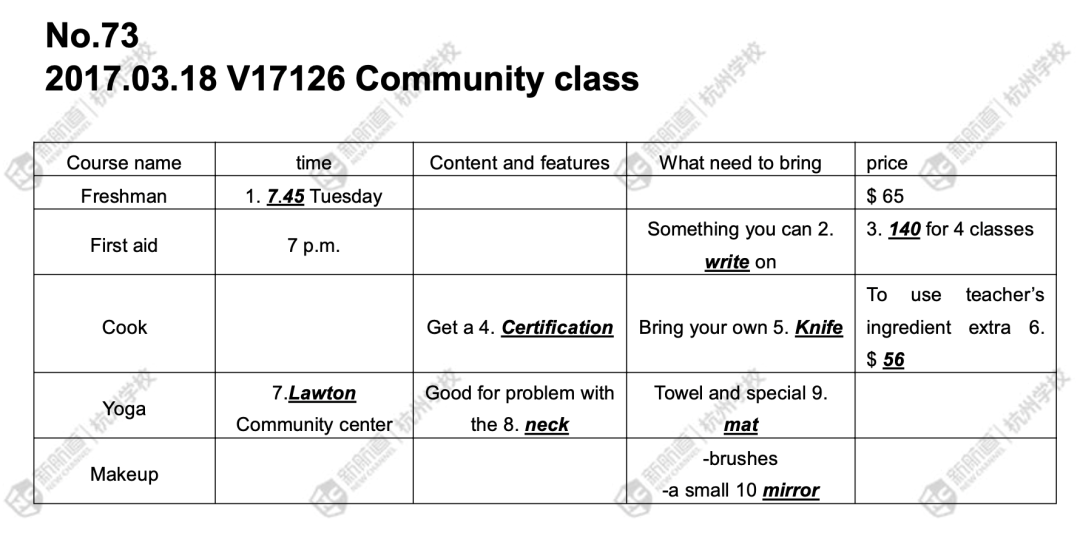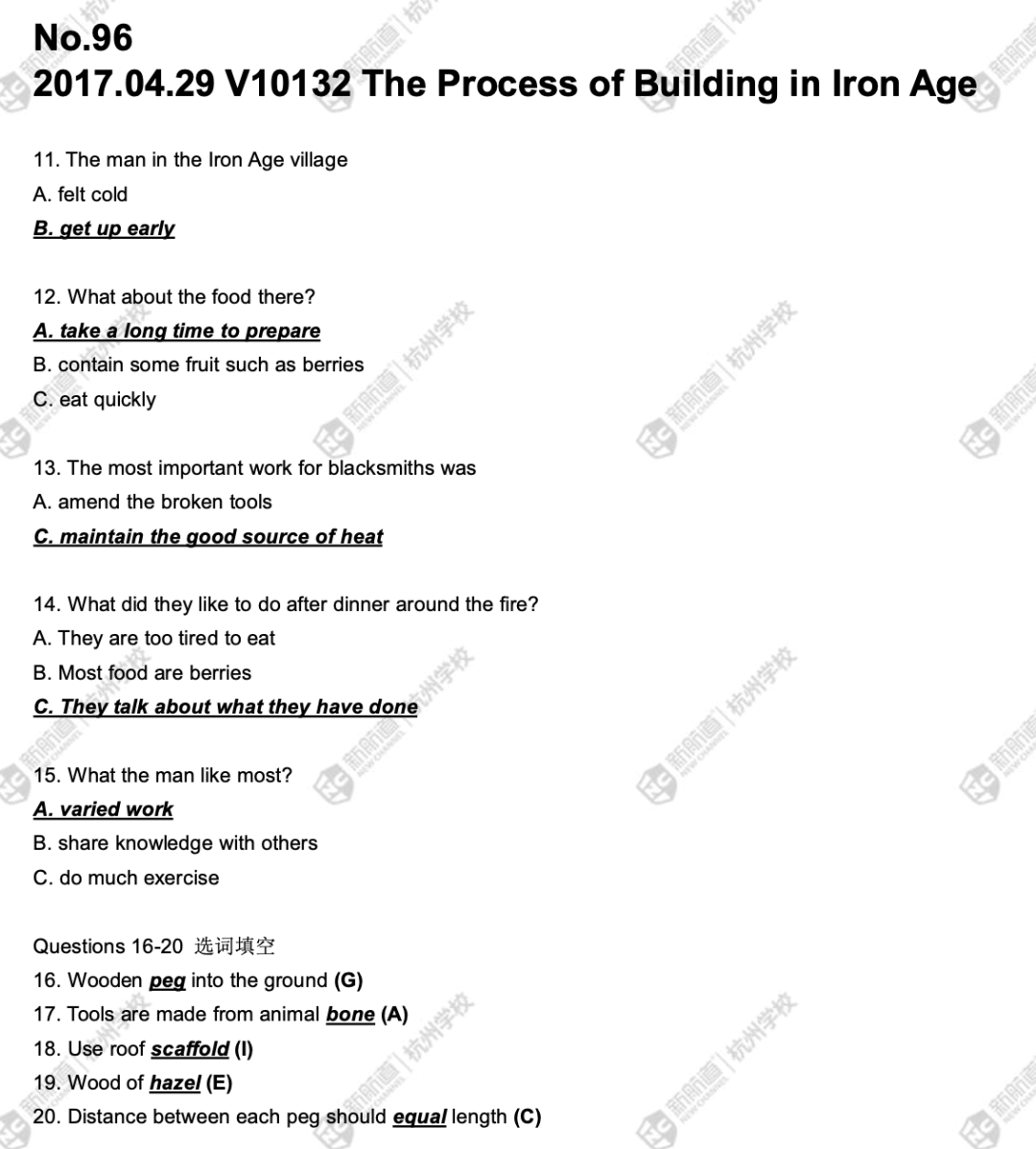一、听力考情
今天的雅思考试听力部分总体来看涉及到的题型和场景还是比较常规的,但据网上回忆很多考生反映音频的语速较快,不少考生刚开始进入P1就有点跟不上,有点措手不及。那么我们一起来看看各部分具体的回忆:
新旧情况:2旧+2新
P1:旧题
场景:一位家长咨询社区大学选课
题型:填空
参考:《新航道雅思听力速递机经S1&S4》No.73,P36

P1点评:本场考试P1内容是高频的课程咨询场景,题型也是常规的表格填空。根据学生回忆主要难点是语速比较快,有点跟不上。具体来看,其中第1、3、6题都涉及了数字考点,第7题涉及了字母拼写,是P1的基础考点。建议在数字方面不太熟练的考生考前有针对性地进行专项训练。从词汇来看,注意certification,knife,mat,mirror等词的拼写。
P2:旧题
场景:关于铁器时代的村落介绍
题型:单选+流程配对
参考:《新航道雅思听力速递机经S2&S3》No.96,P91

P2点评:本场考试P2前半部分是常规的单选题,考生需关注题干中的条件限定,如13和15题的most,根据限定要求帮助排除干扰项。选项属于中长选项,正确答案可能会被替换,考生可以从剑桥真题练习中积累相关替换,熟练常见的替换思维。后半部分流程配对题属于低频题型,流程题考生首先需注意节奏的把握,可关注逻辑承接词帮助定位。从回忆来看,该组题选项词汇难度较大(peg/scaffold/hazel),可能会原词出现,但大概率会出干扰。流程匹配在剑桥中有部分相关篇目(如12T6S3,12T7S3),考生可以进行相关训练。
P3:新题
场景:企业品牌重塑的学术讨论
题型:单选+多选
21 C It is too narrow
22 B inaccurate assessment of the current position
23 B the transferability of its principles
24 C it is very clear
25 B it was a practical help for forming focus groups
26 A They could conduct research more easily about them
27 A It raised the prices too much for its product
28 E It adopted a logo which looked too modern
29 C It chose unpopular spots for its new locations
30 E It refocused its advertising strategy
P3点评:本场考试P3为新题,题干回忆暂时缺失,选项回忆仅供参考。P3部分为学术场景搭配选择类题型,因此是整套题中难度系数最大的一个部分,让很多考生感到头疼。针对P3高频场景和题型,考生一方面需要积累学术场景相关词汇;另一方面可参考剑桥真题P3部分进行题型的横向训练,专项解决考点问题(如审题/排干扰/替换等)。
P4:新题
场景:人造卫星发展史
题型:填空
P4点评:该场考试P4部分是新题,因此回忆暂时缺失。该部分题型是常规的笔记填空,从方法上来看,主要考察学生的定位和抓词能力,难度是不大的。另外P4的内容属于学术讲座,考生可以根据不同的学科进行专业词汇的积累背诵,并利用剑桥真题进行专项训练。
二、口语考情
写在前面:
本篇主要收录2022年8月的雅思纸笔口语和机考口语题目。9月即将迎来换题季,8月依然沿用之前三个月的题库。请大家结合题库,本份预测和串题的思路进行复习。Part12 红色题为必备考题,紫色题为第二重点优先准备
*重点优先按顺序准备题目,一边题库,一边整理语料,根据预测准备,尽量考前确保所有预测都有按顺序刷过一遍* (结尾附建议)
三大必考题:Work or study/ Hometown/ Accommodation
Part1 必备考题
Evening times/Computers/Daily routine/Taking photos / Watches/Old buildings /Talents/Collecting things/Boring things/Meeting places/ Sports /books and reading habits
advertisement /Mirror/Dreams /Arts /Websites/Cinemas/Street markets /E-mails/Time Management / Lost and found /Concentration/TV program /Sitting down/dreams
Part2
必备考题
Describe an occasion when someone gave you positive advice or suggestions about you work
Describe a long walk you ever had
Describe something you received for free
Describe a family member who you want to work with in the future
Describe an interesting neighbor
Describe an important river/lake in your country
Describe a quiet place you like to go
Describe a special day out that cost you little money/didn’t cost you much
Describe something you do to keep fit and healthy
Describe something that surprised you
Describe a contest/competition you would like to participate in
Describe a traditionalproduct in your country
Describe an invention that has changed the world in a positve way
Describe a gift you would like to buy for your friend
Describe a person who contributes to the society
Describe an important event you celebrated
Describe an ambition that you haven’t achieved yet
Describe a person who you follow on social media
第二重点准备
Describe a difficult decision that you once made
Describe a way that helps you save a lot of time
Describe an occasion that you lost something
Describe something you do that can help you concentrate on work/study
Describe apositive changethat you made
Describea famousperson inyour country
Describe atime when you helped a child
Describe a thing you did to learn another language
Describe an item of clothing that someone gave you
Describe a story someone told you and you remember
Describe a course that impressed you a lot
Describe a skill that you learned from older people
Describe someone you really like to spend time with
Describe a time you visited a new place
Describe a house or an apartment which you would like to live in
Describe an interesting song
Describe a city that you think is interesting
Describe a rule that you don’t like
Describe a special cake you received from others
Describe a time when you organised a happy event successfully
Describe a toy you liked in your childhood
Describesomething that you can’t live without
Describe a village that you visited
难题解析串题小tips:
为了节省备考时间和精力,part2我们可以进行一些有效串题,即不同的话题从同一个主题去想思路。需要注意的是串题时需要根据题目中侧重点进行调整,切忌生搬硬套或者频繁出现另外题目中的关键词,导致串题痕迹过于明显。目前话题季可串题的思路很多,可串的题目也很多,这里给大家举个例子,例如下面这两组话题
Describe a way that helps you save time
这个话题算是本季度part2题库中比较有挑战性的话题 学生看到后会觉得头脑一片空白 因为这个话题实在是太宽泛了。所以学生第一反应 总是制定计划(making a plan)或者多任务处理(multitasking)这些主题 然后就大脑一片空白。其实我们可以具体到某个情境中,比如 如果我不喜欢做家务并且工作繁忙,也许请保姆(hiring a nanny)就是一个节约时间的方法。或者平时烧菜太麻烦也不想出去吃饭,那么点外卖(food delivery service)也可以节约时间。
Describe a skill that you learned from older people
Describe a course that impressed you a lot
Describe a positive change that you made
技能活动类的话题大家可以放在一起看待。有学生喜欢体育类的技能比如篮球足球滑板普拉提,也有学生会选择实用的技能 比如烹饪。
假设以做普拉提(Pilates)这种运动锻炼方式来举例子, 因为这项活动是一种很好的锻炼 所以可以是一个保持健康的方式。如果你有上过普拉提课程,也许会觉得这是个令人难忘的课程,因为非常有挑战性,有时还需要身体倒立。如果你之前有一个久坐的习惯(secondary lifestyle),每天放学后就会看电脑玩手机,而现在每天开始做普拉提,所以这是一个积极的改变。
三、阅读考情
今天的阅读考试总结就是“中规中矩“,并且三篇均为旧题。每一篇的题型搭配都是很常规的组合,Passage1的填空+判断,与剑17test1passage1的题型组合和数量完全一致;Passage2的题型组合是段匹+人名匹配+填空,与剑17的test2passag2组合一致;Passage3的题型搭配是单选+判断+句首配句尾,算是剑桥真题书中的第二热门组合。比如剑10test1和剑10test4的第三篇。不过太久没有在考试中出现的句首配句尾题型,让考生们似乎忽略了它的存在。
Passage1 How to make your way out of the food deserts
曾出现于:2016.10.22/2018.10.11
类别:科技
难度:★
题型配比:填空6+判断7
“food desert” 指的是缺乏新鲜食物缺乏或者食品价格昂贵的区域。今天的passage1是一篇旧题,曾经在2016年的10月和2018年的10月分别出现,题型组合是填空6+判断7,是很常规的passage1的形式。文章中提到了一个调查表明,在美国的布鲁克林市中心出现了“food desert”的现象,有些住在市中心的市民收入不高,无法负担新鲜健康的食品。市中心的土地少并且租金成本昂贵,超市无法保证整场的新鲜蔬果的销售,于是城市面临着新鲜健康食物稀缺的问题。
参考答案:
1. location 2. polices 3. government 4. incomes 5.land 6. competition
7 N 8. N 9.Y 10.N 11. TY 12. NG 13. Y
参考文章:
A volunteer effort to map all the food stores in Brooklyn, N.Y., is an example of two rising trends: citizen mapping and increasing scrutiny of urban Americans' access to healthy food
The Brooklyn Food Coalition held its data entry party on the Monday after Martin Luther King, Jr. Day. That night was especially dry and cold; even indoors, everyone was bundled in sweatshirts and scarves. Above couches on which eight volunteers sat with laptops perched on their knees, there hung a framed quote by Indian author Arundhati Roy: "Not only is another world possible, she is on her way. On a quiet day, I can hear her breathing."
The volunteers were collating the results of a recent survey of the 200-some greengrocers and convenience stores in Crown Heights, a neighborhood in Brooklyn, N.Y. As they tapped away on their keyboards, colorful dots appeared on their online map, Foodcensus.org. The map shows the locations of all the food stores in a handful of central Brooklyn neighborhoods. Clicking on a location—one of the dots—brings up a dialogue balloon that displays the store's name and address and whether it carries fresh fruit and vegetables, whole grain bread, low-fat dairy and other healthy options. The volunteers plan to eventually map the entire borough.
Northern and central Brooklyn have some of the unhealthiest food stores in New York City, according to a paper published by New York City District Public Health Office researchers in January. "We want to get to a more specific and detailed description of what that looks like," says Jeffrey Heehs, who leads the mapping project. He hopes the map will help residents find fresh food and help policymakers assess food availability.
The Brooklyn mapping effort represents the intersection of two growing trends: mapping fresh food markets in U.S. cities, and private citizens creating online maps of local features in their neighborhoods. According to Michael Goodchild, a geographer at the University of California at Santa Barbara, citizen cartographers may make maps just for fun; because there is no good government-made map for the area, as in Port-au-Prince, Haiti; or to record problems such as potholes or burned-out traffic lights.
"All this has come out in the past four years," says Michele Ver Ploeg, a USDA economist who prepared a report to Congress in 2009 about "food deserts," or urban areas where the stores sell mostly packaged snacks or fast food instead of fresh produce.
Low-income neighborhoods, where residents are at higher risk for obesity and chronic disease, are often located in food deserts, according to recent research. Researchers have several theories about how food deserts arose. Linda Alwitt and Thomas Donley, marketing researchers at DePaul University in Chicago, wrote in The Journal of Consumer Affairs in 2005 that supermarkets often can't afford large enough properties for their stores in cities. Alwitt and Donley also have posited that when more affluent families moved out of many inner cities in the U.S. during the 1970s and 1980s, supermarkets left as well. City planning researcher Cliff Guy and his colleagues at the University of Leeds in the U.K. wrote in the International Journal of Retail & Distribution Management in 2004 that smaller urban groceries tend to close due to competition from suburban supermarkets.
As fresh food stores leave a neighborhood, residents find it harder to eat well and stay healthy. Food deserts are linked with lower local health outcomes, and they may be a driving force in the health disparities among lower-income and affluent people in the U.S. The issue attracted national attention in 2008, when that year's Farm Bill included, for the first time, funding to study and improve food deserts.
Now more U.S. cities are taking stock of their food landscapes. Last year, the USDA launched a map of food store densities in all the U.S. counties. Mari Gallagher, who runs a private consulting firm, says her researchers have mapped food stores and health statistics for the cities of Detroit, Chicago, Cincinnati and Washington, D.C. These maps help cities identify where food deserts are and, occasionally, have documented that people living in food deserts have higher rates of cancer and diet-related diseases.
The Brooklyn effort differs in that it's run by local core of five volunteers, not professional researchers, who have worked on the project for the past year. To gather data, they simply go to individual stores with pre-printed surveys in hand and check off boxes for the products for sale and whether the store accepts food stamp benefits. The team usually works with other local service groups or high school students looking to fulfill community service hours.
As citizen cartographers, they're a part of the second trend, one that geographers say is becoming increasingly popular. The movement is fueled by new technologies such as mapping apps and GPS-enabled smart phones, other handheld GPS devices, Google maps and OpenStreetMap, an open-source online map with a history of involvement in social justice. After Haiti's devastating January 2010 earthquake, for example, OpenStreetMap contributors built the first digital street map of Port-au-Prince. Brooklyn-based Foodcensus.org uses OpenStreetMap as its base. Such tools are "very, very simple to use and essentially available to everybody," says Goodchild.
Like the Brooklyn Food Coalition volunteers, many citizen cartographers use maps to bring local problems to official attention, Goodchild says. Heehs, the mapping project leader, says that after his group gathers more data, it will compare neighborhoods, draft policies to address local needs and then lobby New York City officials. Foodcensus.org hasn't caught much local or official attention yet, however. The Web site, which launched last month, doesn't yet track its hits so its creators don't know who's looking at it.
Experts who visited the Brooklyn group's site were optimistic but cautious. "This kind of detailed information could be very useful," says Ver Ploeg. To make the map more helpful to both residents and policymakers, she would like to see price data for healthy products, too. Karen Ansel, a registered dietician and a spokesperson for the American Dietetic Association, found the site confusing to navigate. "That said, with this information in place, Foodcensus has the tools to build a more user-friendly site that could be...very helpful to consumers," she says. The group also should ensure their map is available to those who don't have internet access at home, she adds. In fact, 27 percent of Brooklyn residents don't have internet at home and 8 percent rely on dial-up service, instead of high-speed, internet access, according to Gretchen Maneval, director of Brooklyn College's Center for the Study of Brooklyn. The Center's numbers come from data received from the New York City Mayor's Office.
"It's still very much a work in progress," Heehs says of the coalition's online map. They'll start advertising it online and by e-mail to other community groups, such as urban food garden associations, next month. He also hopes warmer days in the spring will draw out more volunteers to finish surveying—they have about two-thirds of Brooklyn left to cover—and to spread awareness.
Passage 2 Australian dingo
曾出现于:2016.06.30/2017.06.17
类别:自然
难度:★★
题型配比:段匹7+人名3+填空3
Passage2是和动物相关的话题,提到了澳洲野犬的生存状况,以及它们对于当地生态系统的影响和作用。题型组合与剑17的test2passag2一致,只不过今天考试中的这篇文章段匹数量从5题增加到了7题。在近两场的考试中,出现段匹的篇章中,数量均为7题,比如上周六的passage3 段匹的数量也是7题,这一题型数量的增加,也是对学生阅读能力和速度的考验。
参考题目:
段匹
14. Dingoes prefer native animals than non-native ones.
15. The introduction of dingoes to Australia
16. Dingo’s preference on predators.
17. The prevention on the number of dingoes.
18. An earlier method to control dingoes.
19. The relationship between Tasmania tigers and dingoes.
20.待回忆
人名匹配
21. The number of dingoes will affect the income of farmers.
22. Therelationship between dingoes and balance of nature.
23. The preference on predators.
填空
24. The extinction ofTasmanian tigers are partly due to the competition from dingoes.
25. Dingoes prefer to choosecalves as their preys.
26. Dingoes can control the number of wild-life animal fromoverpopulation.
Passage 3 Pacific Voyage
曾出现于:2010.6.19
类别:科技
难度:★★★
题型配比:单选5+判断5+句首配句尾4
今天的passage3也是一篇旧题,曾经出现与2010年6月19日的考试中。讲了我们现在对于古代人在太平洋上划着canoe航海的研究。很多专家采取了不同的方法:有的运用古老的装备实地体验,有的装备最新的技术去尝试,有的研究当地人的心理,有的在实验室了建模型研究。另外8月11日考试的passage2也涉及到了古代人航海的话题。从题型组合来说,在连续几场躲不开避不开的选词填空题之后,今天的句首配句尾题型对于很多考生来说是”陌生人”。对于该题型的解题方法比较生疏。其实它也是单选题的经常组合出现的“老伙计”之一。(剑10test1passage3/剑10test4passage3/剑13test1passage3)
四、写作考情
小作文:
动态表格
1911, 1961和2011年,英国的总人口数以及15岁和75岁男女的占比的变化。
今天的小作文和上一场考试一样,考察的组合图,组合图确定思考思路的时候,大家可以从两幅图之间的变量是否存在关系上着手。宏观概括往往可以用Overall, 变量和变量 seem to be poorly/strong correlated 来概括。接着再主体段通过合理分段来解释两者之间的联系。
今天的考题大家不妨看看两幅图之间是否存在因果关系:英国总人口数的改变和15岁和75岁男女占比的变化是否相关,比如说可能是男性数量的增长导致到了总人口的增长。
大作文:
Some people think that the increasing use of computers and mobile phones for communication has a negative effects on young people’s reading and writing skills. Do you agree or disagree?
今天考察的观点类的大作文。题目内容是:
一些人认为越来越多地使用电脑和手机来进行交流对于年轻人的阅读和写作能力会造成消极影响。你同意吗?
这道题很多的同学的跑题现象会出现:
1. 我不同意会有消极影响,然后通过列举积极影响,比如人们的交流变得更加便利来进行证明(跑题的原因是因为有积极的影响也不能证明没有对阅读和写作技能造成消极的影响)
2.我同意有消极的影响,因为长时间盯着屏幕会对年轻人的视力造成影响(视力造成影响和reading and writing skills不相关)。
这道题大家在思考的时候破题的角度可以考虑,平常年轻人是怎么用这些电子设备去进行交流的。
1. 用语音,表情包,视频,很少书写,长此以往会不会导致说有些字忘记怎么写了,一些复杂句由于运用的少也很难书写成功。
2. 书写软件的自动纠正功能和拼写提示功能可能会让年轻人忽视如何准确的书写。